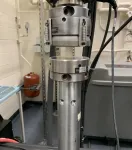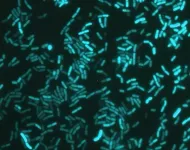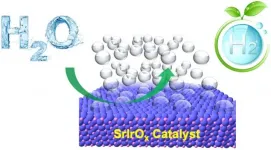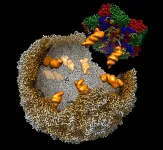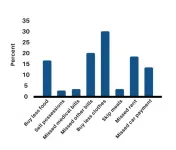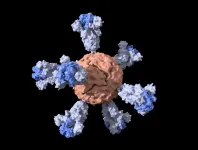Gene therapy strategy found effective in mouse model of hereditary disease TSC
Treatment reverses aspects of tuberous sclerosis complex, which is characterized by noncancerous tumors in multiple organs.
2021-01-08
(Press-News.org) BOSTON - Patients with tuberous sclerosis complex, a genetic disorder characterized by the growth of noncancerous tumors in multiple organs of the body, have limited treatment options. A team led by investigators at Massachusetts General Hospital (MGH) has now shown that gene therapy can effectively treat mice that express one of the mutated genes that cause the disease. The research is published in Science Advances.
The gene, called TSC2, codes for tuberin, a protein that acts to inhibit cell growth and proliferation. When mutations occur in TSC2, resulting in a lack of tuberin in cells, the cells enlarge and multiply, leading to the formation of tumors.
To restore the function of TSC2 and tuberin in a mouse model of tuberous sclerosis complex, researchers developed a form of gene therapy using an adeno-associated virus vector carrying the DNA that codes for a condensed form of tuberin (which fits within the vector's carrying capacity) and functions like the normal full-length tuberin protein. Mice with tuberous sclerosis complex had a shortened life span of about 58 days on average, and they showed signs of brain abnormalities consistent with those that are often seen in patients with the disease. When the mice were injected intravenously with the gene therapy treatment, however, their average survival was extended to 462 days, and their brains showed reduced signs of damage.
"Current treatments for tuberous sclerosis complex include surgery and/or lifelong treatment with drugs that cause immune suppression and potentially compromise early brain development. Therefore, there is a clear need to identify other therapeutic approaches for this disease," says co-lead author Shilpa Prabhakar, an investigator in the MGH departments of Neurology and Radiology. "Adeno-associated virus vectors have been used widely in clinical trials for many hereditary diseases with little to no toxicity, long-term action in nondividing cells, and improvement in symptoms," adds Prabhakar. She notes that benefits can be seen after a single injection, and some forms of the viral vector can efficiently enter the brain and peripheral organs after intravenous injection.
The U.S. Food and Drug Administration has approved a limited number of gene therapy products for use in humans, and the results from this study suggest that clinical trials are warranted to test the strategy's potential in patients with tuberous sclerosis complex.
INFORMATION:
Senior author Xandra Breakefield, PhD, is a geneticist in the departments of Neurology and Radiology at MGH and a professor of Neurology at Harvard Medical School.
This work was supported by the Department of Defense and National Institutes of Health.
About the Massachusetts General Hospital
Massachusetts General Hospital, founded in 1811, is the original and largest teaching hospital of Harvard Medical School. The Mass General Research Institute conducts the largest hospital-based research program in the nation, with annual research operations of more than $1 billion and comprises more than 9,500 researchers working across more than 30 institutes, centers and departments. In August 2020, Mass General was named #6 in the U.S. News & World Report list of "America's Best Hospitals."
ELSE PRESS RELEASES FROM THIS DATE:
2021-01-08
ORLANDO, Jan. 8, 2021 - Florida's threatened coral reefs have a more than $4 billion annual economic impact on the state's economy, and University of Central Florida researchers are zeroing in on one factor that could be limiting their survival - coral skeleton strength.
In a new study published in the journal Coral Reefs, UCF engineering researchers tested how well staghorn coral skeletons withstand the forces of nature and humans, such as impacts from hurricanes and divers.
The researchers subjected coral skeletons to higher stresses than those caused by ocean waves, says Mahmoud Omer, a doctoral student in UCF's Department ...
2021-01-08
A research team at the University of Basel has discovered immune cells resident in the lungs that persist long after a bout of flu. Experiments with mice have shown that these helper cells improve the immune response to reinfection by a different strain of the flu virus. The discovery could yield approaches to developing longer-lasting vaccinations against quickly-mutating viruses.
At the start of the coronavirus pandemic, some already began to raise the question of how long immunity lasts after weathering SARS-CoV-2. The same question has now arisen regarding the COVID-19 vaccination. A key role is played by immunological memory - a complex interplay of immune cells, antibodies and signaling ...
2021-01-08
Humans have them, so do other animals and plants. Now research reveals that bacteria too have internal clocks that align with the 24-hour cycle of life on Earth.
The research answers a long-standing biological question and could have implications for the timing of drug delivery, biotechnology, and how we develop timely solutions for crop protection.
Biological clocks or circadian rhythms are exquisite internal timing mechanisms that are widespread across nature enabling living organisms to cope with the major changes that occur from day to night, even across seasons.
Existing inside cells, these molecular rhythms use external cues such as daylight and temperature to synchronise ...
2021-01-08
CORVALLIS, Ore. - Efficiently mass-producing hydrogen from water is closer to becoming a reality thanks to Oregon State University College of Engineering researchers and collaborators at Cornell University and the Argonne National Laboratory.
The scientists used advanced experimental tools to forge a clearer understanding of an electrochemical catalytic process that's cleaner and more sustainable than deriving hydrogen from natural gas.
Findings were published today in Science Advances.
Hydrogen is found in a wide range of compounds on Earth, most commonly combining with oxygen to make water, and it has many scientific, industrial and energy-related roles. It also occurs in the form of hydrocarbons, compounds consisting of hydrogen and carbon such ...
2021-01-08
Researchers have for the first time identified the way viruses like the poliovirus and the common cold virus 'package up' their genetic code, allowing them to infect cells.
The findings, published today (Friday, 8 January) in the journal PLOS Pathogens by a team from the Universities of Leeds and York, open up the possibility that drugs or anti-viral agents can be developed that would stop such infections.
Once a cell is infected, a virus needs to spread its genetic material to other cells. This is a complex process involving the creation of what are known as virions - newly-formed infectious copies of the virus. Each virion is a protein shell containing a complete copy of the virus's genetic code. ...
2021-01-08
Corals have evolved over millennia to live, and even thrive, in waters with few nutrients. In healthy reefs, the water is often exceptionally clear, mainly because corals have found ways to make optimal use of the few resources around them. Any change to these conditions can throw a coral's health off balance.
Now, researchers at MIT and the Woods Hole Oceanographic Institution (WHOI), in collaboration with oceanographers and marine biologists in Cuba, have identified microbes living within the slimy biofilms of some coral species that may help protect the coral against certain nutrient imbalances.
The team found these microbes can take up and ...
2021-01-08
More than half of Latina mothers surveyed in Yolo and Sacramento counties reported making economic cutbacks in response to the pandemic shutdown last spring -- saying they bought less food and missed rent payments. Even for mothers who reported receiving the federal stimulus payment during this time, these hardships were not reduced, University of California, Davis, researchers found in a recent study.
"Latino families are fighting the pandemic on multiple fronts, as systemic oppression has increased their likelihood of contracting the virus, having complications from the virus and having significant economic hardship due to the virus," said Leah C. Hibel, associate professor of human development and family studies at UC Davis and ...
2021-01-08
Like Peter Pan, some cells never grow up. In cancer, undifferentiated stem cells may help tumors such as glioblastoma become more aggressive than other forms of the disease. Certain groups of genes are supposed to help cells along the path to maturity, leaving their youthful "stemness" behind. This requires sweeping changes in the microRNAome -- the world of small non-coding material, known as microRNAs, that control where and when genes are turned on and off. Many microRNAs are tumor-suppressive; in cancer, the microRNAome is distorted and disrupted. Recent work by researchers at Brigham and Women's Hospital pinpoints critical changes in an enzyme known as DICER, which create a cascade of effects on this microRNAome. ...
2021-01-08
The BioScience Talks podcast features discussions of topical issues related to the biological sciences.
In a career-spanning installment of the journal BioScience's In Their Own Words oral history series, Missouri Botanical Garden President Emeritus Peter Raven illuminates numerous topics, sharing insights related to the sustainability of human civilization, the COVID-19 pandemic, and the importance of science in addressing the world's greatest challenges.
Raven, a recent coauthor of "A Call to Action: Marshaling Science for Society," highlights the importance of public outreach in overcoming deeply rooted societal problems. Among them, he argues that our present economic system "sees natural productivity like every other ...
2021-01-08
Before the pandemic, the lab of Stanford University biochemist Peter S. Kim focused on developing vaccines for HIV, Ebola and pandemic influenza. But, within days of closing their campus lab space as part of COVID-19 precautions, they turned their attention to a vaccine for SARS-CoV-2, the virus that causes COVID-19. Although the coronavirus was outside the lab's specific area of expertise, they and their collaborators have managed to construct and test a promising vaccine candidate.
"Our goal is to make a single-shot vaccine that does not require a cold-chain for storage or transport. If we're successful at doing it ...
LAST 30 PRESS RELEASES:
[Press-News.org] Gene therapy strategy found effective in mouse model of hereditary disease TSC
Treatment reverses aspects of tuberous sclerosis complex, which is characterized by noncancerous tumors in multiple organs.
